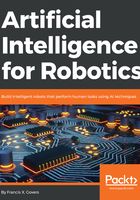
Foundation for Advanced Robotics and AI
This book is for readers who have already begun a journey learning about robotics and wish to progress to a more advanced level of capability by adding AI behaviors to your robot, unmanned vehicle, or self-driving car. You may have already made a robot for yourself out of standard parts, and have a robot that can drive around, perhaps make a map, and avoid obstacles with some basic sensors. The question then is: what comes next?
The basic difference between what we will call an AI robot and a more normal robot is the ability of the robot and its software to make decisions, and learn and adapt to its environment based on data from its sensors. To be a bit more specific, we are leaving the world of deterministic behaviors behind. When we call a system deterministic, we mean that for a set of inputs, the robot will always produce the same output. If faced with the same situation, such as encountering an obstacle, then the robot will always do the same thing, such as go around the obstacle to the left. An AI robot, however, can do two things the standard robot cannot: make decisions and learn from experience. The AI robot will change and adapt to circumstances, and may do something different each time a situation is encountered. It may try to push the obstacle out of the way, or make up a new route, or change goals.
The following topics will be covered in this chapter:
- What is Artificial Intelligence (AI)?
- Modern AI – nothing new
- Our example problem
- What you will learn in this book – AI techniques covered
- Introduction to TinMan, our robot
- Keeping control – soft real-time control
- The OODA loop – basis for decision making